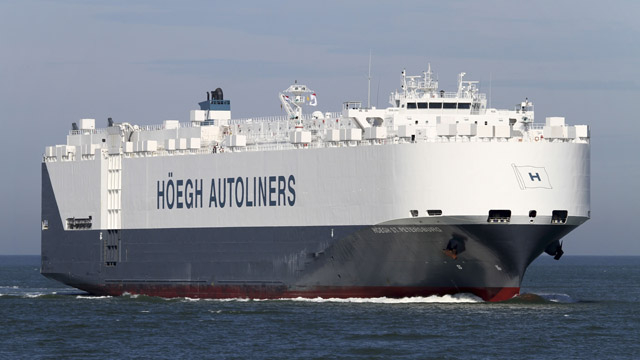Oslo: Norwegian car carrier Hoegh St Petersburg has reached the area in the southern Indian Ocean off Australia where two floating objects, suspected to be debris from the missing Malaysian jetliner, were spotted, the ship's owner said on Thursday.
Norwegian vessel Höegh St Petersburg was asked by Australian authorities to assist in the search of the debris of the missing Boing 777 of Malaysia Airlines flight MH370.
The car carrier was on its way from Madagascar to Melbourne when it got a request from Australian authorities to assist in investigating the objects spotted by satellite four days ago in one of the remotest parts of the globe, around 2,500 km (1,500 miles) southwest of Perth.
"We've got a request from Australian authorities to search the area, and we will assist as long as needed," said Kristian Olsen, a spokesman at Hoegh Autoliners.
A British naval ship also joined the search, the UK Ministry of Defence said. The survey ship HMS Echo is in the Indian Ocean, where the Australian prime minister said a satellite had detected objects including a 24-metre (79-feet) long piece of debris.
The ship is designed to collect ocean data to support submarine and amphibious operations and is equipped with a survey motor boat and a contingent of Royal Marines.
The larger of the objects spotted in the southern Indian Ocean measured up to 24 metres (79 ft) long and appeared to be floating on water several thousand metres deep, Australian officials said. The second object was about 5 metres (16 feet) long.
No confirmed wreckagehas been found since the plane vanished from air traffic control screens off Malaysia's east coast early on March 8, less than an hour after taking off from Kuala Lumpur for Beijing.
Planes dispatched
Four military search planes had earlier been dispatched to determine whether two large objects bobbing in a remote part of the Indian Ocean are debris from the missing Malaysia Airlines flight.
The satellite photo above, supplied by the Australian Maritime Safety Authority (AMSA), shows the objects floating in the southern Indian Ocean. The imagery has been analyzed by specialists in Australian GeoSpacial-Intelligence Organization.
One of the objects spotted by satellite imagery was 24 metres (almost 80 feet) in length and the other was 5 meters (15 feet).
There could be other objects in the area, a four-hour flight from Australia's southwestern coast, said John Young, manager of the Australian Maritime Safety Authority's emergency response division.
"This is a lead, it's probably the best lead we have right now," Young said. He cautioned that the objects could be seaborne debris along a shipping route where containers can fall off cargo vessels, although the larger object is longer than a container.
Young told a news conference in Canberra, Australia's capital, that planes had been sent to the area about 2,500 kilometers (1,550 miles) southwest of Perth to check on the objects. He said satellite images "do not always turn out to be related to the search even if they look good, so we will hold our views on that until they are sighted close-up."
Objects 'possibly' related to MH370 spotted
Australian Prime Minister Tony Abbott told parliament on Thursday that "new and credible information" based on satellite imagery had come to light, and four long-range surveillance planes were being diverted to look into the find in the southern Indian Ocean.
The graphic above, released by Australian Maritime Safety Authority (AMSA), shows an area in the southern Indian Ocean that the AMSA is concentrating its search for the missing Malaysia Airlines Flight MH370 on. AMSA response division manager John Young has identified their search will cover a massive 600,000 square kilometers (232,000 square miles) area, saying it will take weeks to search thoroughly.
"Following specialist analysis of this satellite imagery, two possible objects related to the search have been identified," Abbot said.
The Australian Maritime Safety Authority had said that the vast area it was scouring had been "significantly refined" following closer analysis of flight MH370's fuel reserves.
The Boeing 777 vanished in the early hours of March 8 after veering drastically off course over the South China Sea while en route to Beijing.
Sketchy radar and satellite data had resulted in investigators proposing two vast search corridors, stretching south into the Indian Ocean and north over South and Central Asia.
Most analysts had favoured the maritime southern corridor, pointing out the unlikelihood of the airliner passing undetected over nearly a dozen countries.
But the international search has been marked by numerous false leads, and Abbott sought to temper expectations.













